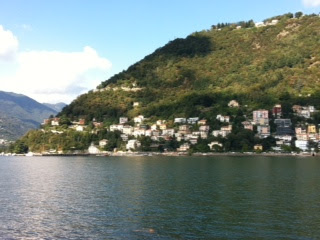Gianni introduced us to a technique for pairing food and wine. Before our course is completed, we will have tasted 29 food and wine pairings. Today, we learned the basics and paired two wines (a decanted 2000 Batasiolo Barolo and a 2010 Candido Salice Salentino rose' "Le Pozzelle") with an 18-month old Grana Padano cheese (very similar to Parmigiana Reggiana).
The technique calls for tasting the wine and numerically rating it on a 1-10 scale for intensities of smell and persistency, and again for intensities of taste for sweetness, softness, acidity, sapidity, tannins (tactile sensation), and alcohol content. These numbers are plotted on a graph. Next, the food is tasted and likewise measured for sapidity, bitterness, acidity, sugar, fat, natural sweetness, succulence, and greasiness, as well as persistence of taste, spiciness, smell.
The food scores are plotted on the the same graph, which juxtaposes the wine and food measurements in such a fashion that the sweetness and softness of the wine is opposite the food's rating for bitterness and acidity. Similarly, measurement of the food's natural sweetness is on the opposite side of the graph's rating for wine acidity. Another example: The wine's tannins, which produce that tactile sensation and which absorb saliva, is graphed opposite the food's measurement of succulence, which produces saliva even upon smell alone.
When plotted, good pairings will create a geometrically similar pattern on the graph. The idea is to train the mouth and brain to make these assessments without having to plot a graph and gaze at geometric similarities. If that fails, we will at least have notes from 29 wine tastings and food pairings.
Here's how the Salice Salentino rose' and the Barolo worked out. The full-bodied Barolo, on the graph and in the mouth, overpowered our 18-month old cheese, whereas the rose' and the Grana Padano were both harmonious in the mouth and geometrically similar on the chart. Gianni's suggestion, if you want to pair Grana Padano with a full-bodied Barolo, try the same cheese that has aged longer, say 36 months, so that the cheese can accompany the wine, creating a fusion of sensations that leave the palate at the same time.
The short version: Pair a young Candido Salice Salentino rose' with a young Grana Padano or Parmigiana Reggiana cheese.
Sent from my iPhone
































